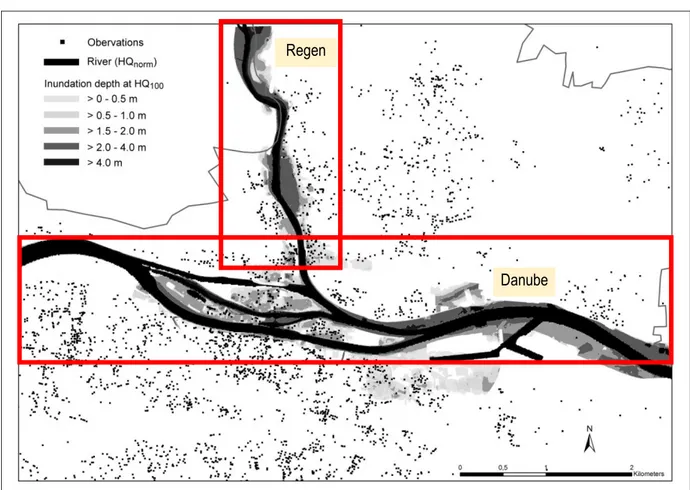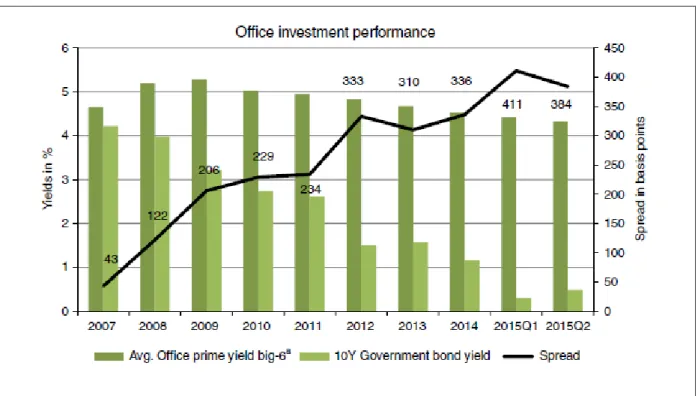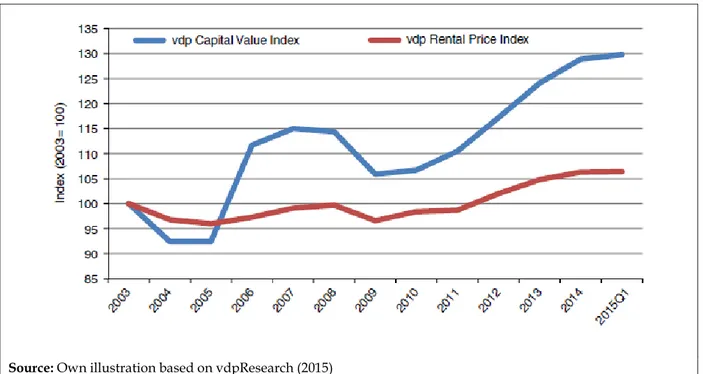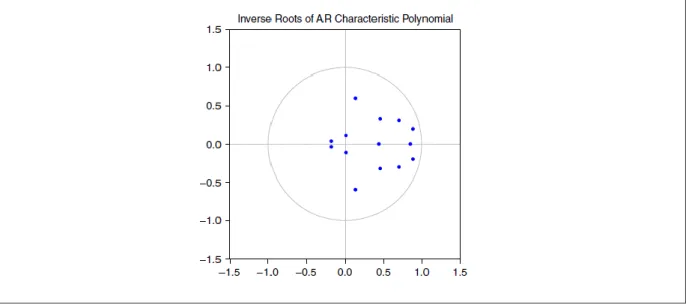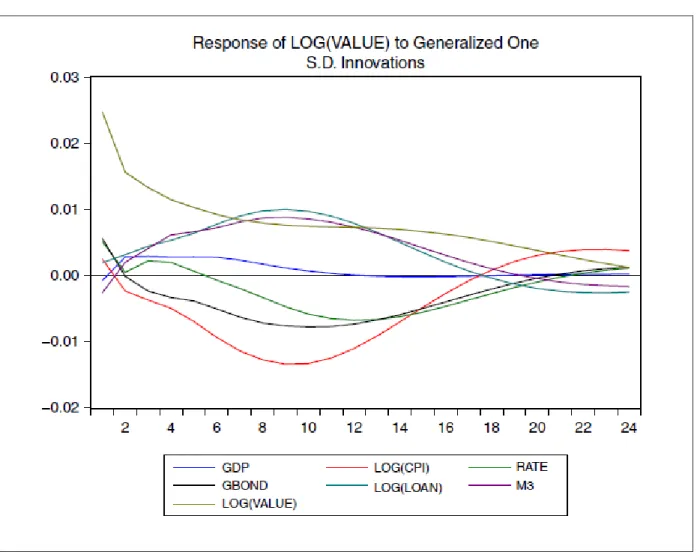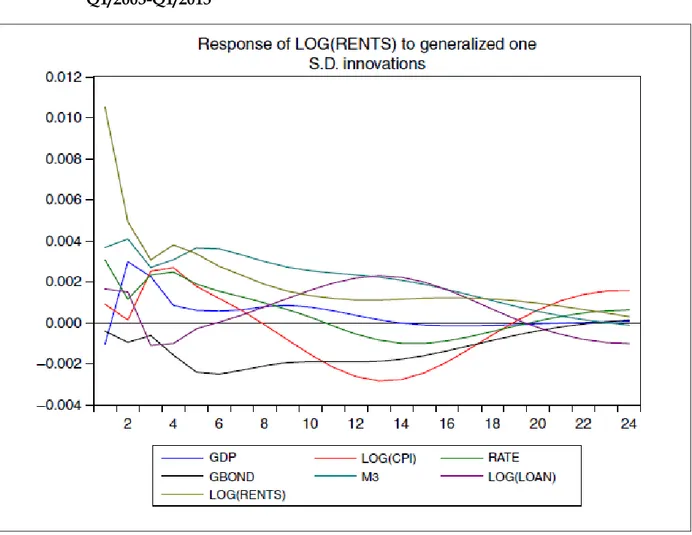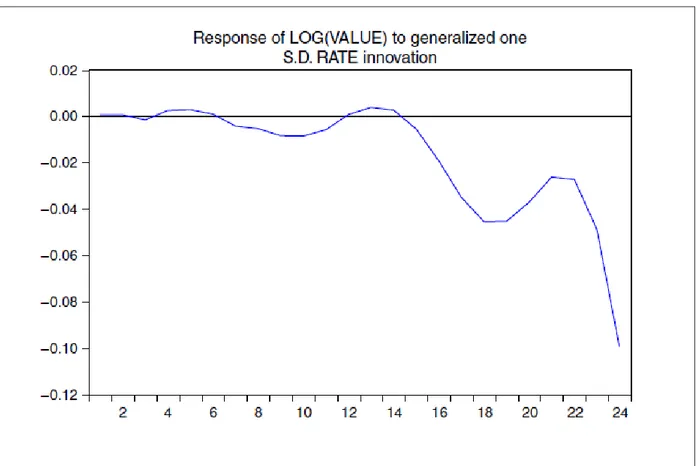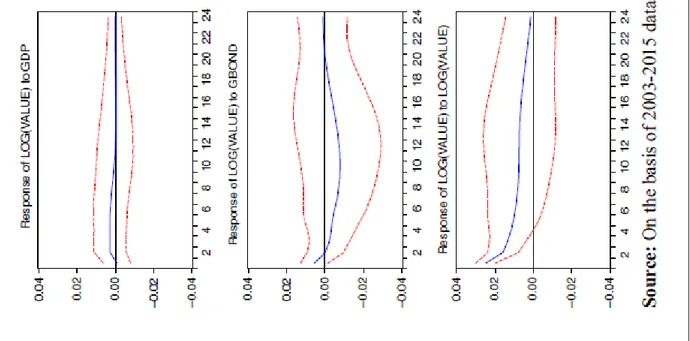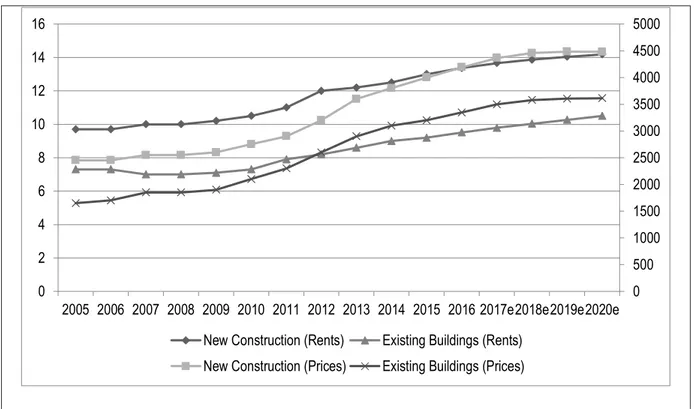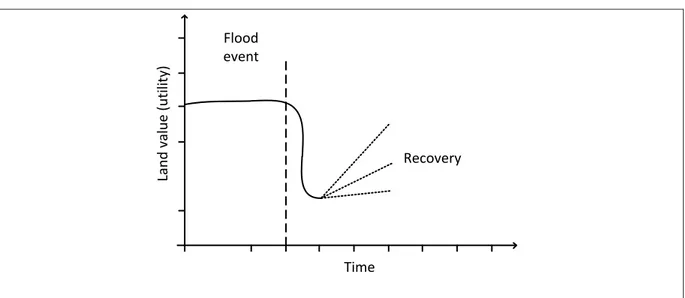Selected Determinants of Real Estate Market Behavior
and their Impact Patterns
A
DISSERTATION SUBMITTED IN PARTIAL FULFILLMENT OF THE REQUIREMENTS FOR THE DEGREE OFD
OCTOR RERUM POLITICARUM(D
R.
RER.
POL.)
S
UBMITTED TOTHE
F
ACULTY OFB
USINESS, E
CONOMICS ANDM
ANAGEMENTI
NFORMATIONS
YSTEMS OF THEU
NIVERSITY OFR
EGENSBURGS
UBMITTED BYJonas Hahn
MASTER OF SCIENCE,UNIVERSITY OF REGENSBURG
ADVISORS:
PROF. DR. SVEN BIENERT
PROF. DR. GREGOR DORFLEITNER
COPYRIGHT © Jonas Hahn, 2018
Table of Content
List of Tables ... III List of Figures ... IV List of Abbreviations ... VI
1. Introduction ... 1
1.1. General Motivation – Changing Framework Conditions for Real Estate ... 2
1.1.1. A paradigm change in economic environments and interest rate policy ... 4
1.1.2. Intensifying extreme weather events ... 6
1.1.3. Expiring resources for property heating ... 9
1.2. Research Questions... 11
1.3. Course of Analysis ... 12
1.4. References ... 13
2. Office properties through the interest cycle: Performance impact and economic sustainability in Germany ... 19
2.1. Introduction ... 20
2.2. Review of literature ... 23
2.3. Market observations against a sustainable reaction to interest rate changes ... 25
2.3.1. The rental market and the investment market have decoupled ... 25
2.3.2. The correlation pattern differs throughout the market phases ... 25
2.3.3. Although widely interconnected, the development of property prices should be rather explained by economic fundamentals than pure interest effects ... 26
2.4. Empirical analysis – impulses and reactions of the German office market ... 28
2.4.1. Data ... 28
2.4.2. Descriptive data analysis ... 29
2.4.3. Methodology ... 30
2.4.4. Empirical results ... 38
2.5. Summary and outlook... 43
2.5.1. Further research ... 43
2.5.2. Limitations ... 44
2.6. References ... 44
2.7. Annex ... 50
3. How flood risk impacts residential rents and property prices – empirical analysis of a German property market ... 56
3.1. Introduction ... 57
3.2. Literature Review ... 59
3.3. Empirical Analysis ... 63
3.4. Conclusion ... 72
3.5. References ... 74
3.6. Annex ... 76
4. Does ‘clean’ pay off? Housing markets and their perception of heating technology 80 4.1. Introduction ... 81
4.2. Literature Review ... 81
4.3. Empirical analysis ... 88
4.4. Conclusion and Discussion ... 105
4.5. References ... 109
4.6. Annex 1 – Purchasing Prices (Hedonic Regression Output) ... 111
4.7. Annex 2 – Rental Prices (Hedonic Regression Output) ... 112
5. Conclusion ... 113
5.1. Executive Summary ... 113
5.2. Final Remarks and Outlook ... 115
5.2.1 General challenges of empirical real estate research (in Germany) ... 116
5.2.2 Research results in a broader context ... 117
List of Tables
Table 1.1: Overview of Mega Trends and their impact on Framework Conditions ... 3
Table 1.2: Climatic Aspects and their Real Estate-related Impacts... 7
Table 1.3: Extreme Weather Events and their Economic Damages (> 1 billion US dollars) ... 7
Table 2.1: Simple correlation factors in different market phases ... 28
Table 2.2: Overview of model parameters and data sources ... 29
Table 2.3: Correlation matrix of all variables in both models ... 30
Table 2.4: Augmented Dickey Fuller test – level values ... 34
Table 2.5: Augmented Dickey Fuller test – first differences... 35
Table 2.6: Results of the Johansen system cointegration test ... 36
Table 2.A1: Equation outputs regarding Structural Breaks in the Data ... 50
Table 3.1: Output of results regarding flood risk ... 66
Table 3.2: Output of results regarding specific water depths (standard deviation in brackets) . 66 Table 3.3: Output of the control variables in the Rental and Sales Model ... 68
Table 3.A1: Output Rental Model ... 76
Table 3.A2: Output Sales Price Model ... 77
Table 4.1: Overview of Literature and included regression variables ... 84
Table 4.2: Descriptive Data Statistics: Rental Housing Model ... 91
Table 4.3: Descriptive Data Statistics: Residential Sales Model ... 92
Table 4.4: Classification of Heating Technology ... 94
Table 4.5: Output of Price Impact by Heating Technology ... 95
Table 4.6: Impact of Federal State Macro-Location on Housing Prices ... 100
Table 4.7: Impact of Quality of Equipment on German housing prices ... 101
Table 4.8: Full Output – Sales Price Model Estimate ... 111
Table 4.9: Full Output – Rental Price Model Estimate ... 112
List of Figures
Figure 1.1: Cross-Segment Cap Rates in Germany, 2008-2017 ... 5
Figure 1.2: Observations of the Flood Risk study in the local river context ... 9
Figure 1.3: Static Reach of Known Non-Renewable Resource Reserves ... 10
Figure 2.1: The development of office investment volume in Germany ... 22
Figure 2.2: A yield comparison of aBIG6 office investments and government bonds ... 22
Figure 2.3: Capital values and rental price index for office properties ... 27
Figure 2.4: The development of office capital values (green) and the European prime interest rate (grey) ... 27
Figure 2.5: Unit root graph for the VAR capital value model ... 36
Figure 2.6: Unit root graph for the VAR rental price model ... 36
Figure 2.7: Generalized impulse-response function in the VAR capital value model Q1/2003- Q1/2015 ... 38
Figure 2.8: Generalized impulse-response function in the VAR rent price model Q1/2003- Q1/2015 ... 39
Figure 2.9: Generalized prime rate impulse-response function in the VAR capital value model 2009-2015 ... 42
Figure 2.A1. Impulse-responses in the VAR rental price model ... 51
Figure 2.A2. Impulse-responses VAR capital value model ... 53
Figure 2.A3. Residuals of the VAR capital value model ... 54
Figure 3.1: The development of rents and condominium prices in Regensburg ... 58
Figure 3.2: The ‘bounce back’ effect in property markets after flood events ... 60
Figure 3.3: Multiple ‘bounce back’ effects over time ... 61
Figure 3.A1: Isolated Effect of Location on Rents ... 78
Figure 3.A2: Isolated Effect of Location on Sales Prices ... 78
Figure 3.A3: Spline for Building Year Variable in Rents and Sales (extended timespan, rents left) ... 79
Figure 4.1: Residual Analysis – Spatial Autocorrelation within the Data Set ... 90
Figure 4.2: Price effects of heating technology in sales and rental market ... 95
Figure 4.3: The Price Impact of Energy Consumption in Sales Markets... 96
Figure 4.4: The Price Impact of Energy Consumption in Rental Markets ... 97
Figure 4.5: Residential Sales Price Heatmap – Germany ... 98
Figure 4.6: Residential Rent Price Heatmap – Germany ... 99
Figure 4.7a/4.7b: The Price Spline Function of rooms and area in housing sales markets ... 102
Figure 4.8a/4.8b: The Price Spline Function of rooms and area in rental housing markets ... 102
Figure 4.9: The Price Spline Function of the number of stories in sales (left) and rental housing markets ... 103
Figure 4.10: The Price Spline Function of the construction year in sales (left) and rental housing markets ... 104
List of Abbreviations
CHP Combined Heat and Power (Unit) c.p. ceteris paribus
ECB European Central Bank
EPC Energy Performance Certificate GAM Generalized Additive Model GDP Gross Domestic Products
IPCC Intergovernmental Panel on Climate Change
OECD Organisation for Economic Co-operation and Development S.D. Standard Deviation
S.E. Standard Error SQM Square Meter
TR Total Return
VAR Vector-Autoregression, vector-autoregressive
1. Introduction
Anthropogenic actions are frequently associated with critical situations in both economic and ecological terms (Moss et al., 2010, Taylor, 2009, and Shiller, 2012). In an economic sense, these critical situations recently comprised significant turbulences and rampant risks, which ultimately peaked in a global financial crisis and recession. Stress levels were tremendous to the extent that, in order to sustain system-relevant industries and, in fact, entire economies, several central banks responded to these developments by implementing measures of monetary policy, specifically concepts of Quantitative Easing (‘QE’) and a reduction of the prime interest rate level.
Amidst substantial financial turbulences, another major and global concern is consorting, being anxiety regarding the worsening ecological health of planet Earth. At a higher level and in the long run, this is fueled by phenomena such as climate change and global warming, but also in short and medium terms risks are arising from issues such as extreme weather events and increasing scarcity of resources as well as excessive consumption of resources by industrialization or technological combustion. More than a few scientists take the view that these long- and short-term aspects are actually interrelated (in particular, Cook et al., 2013 and IPCC, 2014a, regarding the role of human kind as a perpetrator of climate change, Tompkins and Adger, 2004, as well as Edenhofer et al., 2012, covering possible functional chains between resources consumption and climate change as well as Stott, 2016, and Colbert et al., 2013 regarding the question, whether extreme weather events can be related to climate change).
These phenomena and their progressing development depict enormous challenges to many fields of economic activity. They also constitute changing framework conditions for real estate, as both markets actors and the industry’s products are facing increased importance of topics such as resilience, security of supply and demand, the question of sustainability in business models and changing risks.
In this context, the superior goal of this dissertation is to relate the megatrends introduced to a real estate context and to analyze, in which way associated problems impact elements from the real estate value chain, essentially rental and purchasing prices or capital values, as well as market-inherent behavior.
The rest of the introductory chapter is structured as follows: section 1.1 will further specify the changing framework conditions for real estate as the underlying motivation of this thesis in greater detail. For that, selected aspects of the framework conditions will be further outlined:
section 1.1.1 describes the fundamental developments and challenges in the context of interest rate levels and connects them to real estate as both an asset class as well as an economic good.
Section 1.1.2 will collect general information regarding currently intensifying extreme weather events and related damages caused to real estate, thereby outlining how extreme weather events as one manifestation of climate change depict action fields and risk factors to property owners. Section 1.1.3 will then present figures on the role of real estate in terms of resource consumption and reflect them to typical resources used in property heating, before building a bridge to heating system efficiency and renewable energy as viable solutions to the challenge.
Based on the changing framework conditions outlined, chapter 1.2 will frame the explicit research questions of the three empirical studies included in this dissertation. Chapter 1.3 will provide the publication status of the three papers and briefly touch on the variety of methodological approaches used in the empirical work, which will then be provided in chapters 2, 3 and 4 of this dissertation.
1.1. General Motivation – Changing Framework Conditions for Real Estate From several points of view, properties and real estate investments make a difference compared to other asset classes. That is specifically due to their heterogeneity and the connected low substitutability, the duration of development processes, the relatively high investment amounts and transaction costs, the length of the life cycle as well as the stationary character of properties (Bone-Winkel/Focke/Schulte, 2016).
This leads to the initial consideration that real estate may not be comparable to other financial products or asset classes in terms of their value creation, but that it may be subject to very own and specific impact factors that drive or constrain the financial performance. These factors may not be directly significant in other asset classes such as securities or bonds or at least may show different reaction patterns in a comparative analysis.
Based on this finding, several fields of research are derived from contemporary observations on current and future mega trends in a real estate context, which reflect the current changes in framework conditions. These were identified based on extensive review of existing literature, as contained in the papers included in sections 2 to 4, as well as a selection of concepts and reports published by international associations and public authorities.
The selected observations of changing framework conditions for real estate market actors and investments comprise the following phenomena:
Table 1.1: Overview of Mega Trends and their impact on Framework Conditions Framework Condition Symptoms of changing framework conditions in Real Estate
Financial Framework and Investment
Attractiveness
• Challenging Risk Diversification and Asset Allocation
• Yield Compression and ABBA Strategies1
• Concerns regarding an Upcoming Interest Shift Leap Physical Climate
Change and Extreme Weather Events
• Local and international efforts on managing and adapting to Extreme Weather Events, intensifying climate regulations
• Increasing frequency and hazard of extreme weather events
• Excessive Insurance Premia and Lack of Insurability Inter-generational
Sustainability and Resource Conservation
• Long-term concepts for handling property-related resources
• ‘German’ Energy Shift
• Net-Zero Energy Building Standards
• Expectations on state-of-the-art of Market Participants
Source: own collection, based on Stevens, 2017, Liow and Schindler, 2017, Stott, 2016, Hirsch, Braun and Bienert, 2015, IPCC, 2012, and Li, Yang, and Lam, 2013.
While table 1.1 serves to give an overview of the changing framework conditions for real estate, they will be exemplified and further discussed in chapters 1.1.1. to 1.1.3. In particular, three aspects appear expedient for related research to be conducted in this work:
1. In the light of economic turbulences and uncertainty, whether and to which extent real estate is subject to macro-economic determinants and how a change in these determinants (such as an interest leap) influences rents and capital values
2. In the light of increasing risks from extreme weather events, whether and to which extent real estate is subject to increased flood risk and specifically how this risk influences residential rents and housing prices
3. In the light of substantially decreasing reserves in natural resources, whether and to which extent real estate is subject to changing environmental awareness and action, specifically the implementation of modern heating technology, including technology fueled by renewable energy sources.
These topics were identified and selected with the purpose of gaining a profound understanding of how they impact or interact with real estate performance. It is expected that
1 ‚ABBA‘ describes the investment strategy of diversification the portfolio by incorporating A-grade properties or A-micro locations in subprime (‘B’) cities or B-grade properties or B-micro locations in core (‘A’) investment locations, cf. Swiss Life AM, 2017.
both the economic and the ecological circumstances mentioned before come with respective economic impact and developments.
This thesis aims to create an extended understanding and a large bandwidth of empirical evidence on the framework conditions mentioned before and their impact in a real estate context. This comprises both the question of significance for property performance as well as specific market reactions and market behavior patterns.
1.1.1. A paradigm change in economic environments and interest rate policy
In terms of economic turmoil, the international economy survived multiple global-scale recessions already at the beginning of the 21st century, which have peaked in the financial breakdown of 2009 for the moment. In this context, real assets were found closely linked to this global financial crisis. The connection is both of indirect nature, through the breakdown of mortgage markets due to excessive non-performing loans, as well as of direct nature due to sudden shocks in valuation, lower prices from forced sales and lower demand from lower affordability or illiquidity (Favara and Giannetti, 2017; Jarsulic, 2012). However, the industry plays a dual role: on the one hand side, property investments and financing have contributed to what ultimately resulted in the current low-interest rate environment;2 on the other hand side, the interest low determines real estate prices and performance today and in a longer term.
Several programs of the European Central Bank were implemented in order to primarily react to countries increasing their debt levels to manage the consequences of the financial crisis and to countries backing their economic stability, even though these reactions themselves constitute further fiscal risks in the form of asset price inflation, pricing exaggerations or overheating tendencies (Dreger and Kholodilin, 2013).
Investment volumes have increased ever since throughout the property market segments with a lot of this development being caused by higher affordability and higher liquidity due to lower interest payments and debt service volume. Exaggerations in pricing, however, have been a side effect of this development, as the supply of new properties has not kept up with the significantly increased demand. Also, the lack of profitable investment alternatives in the low-interest environment has led to investment pressure amongst national and international
2 After all, real estate as an asset class was not quite unblameable regarding the evolution of the crisis. Specifically, the US mortgage crisis rooted in residential real estate-related decisions and developments, which put pressure on institutional and private investors globally as well as across segments and asset classes due to internationally connected capital flows.
capital allocators, which caused the mentioned exaggerations mainly in sales markets. It should not go unmentioned that rent markets have decoupled from this development.
Therefore, a significant yield compression has gone hand in hand with this (BNP Paribas Real Estate, 2017), as shown in the following illustration.
Figure 1.1: Cross-Segment Cap Rates in Germany, 2008-2017
Source: own illustration based on vdpResearch, 2018
Yet, institutional investors have, on average, significantly increased the real estate share of their portfolios throughout the recent years (Syrjaenen, 2017). Amongst other reasons, real estate is believed to be one of the few asset classes for yield outperformance also in times of investment pressure due to cheap capital and an intensified capital investment pressure with fewer options for asset allocation. Also, real estate is regarded a good instrument for diversification due to low correlation with other asset classes (Credit Suisse, 2014).
On the one hand, economic theory and intuition suggest that, as interest rates drive liquidity in the market, property prices are negatively impacted by the interest level and housing prices increase when interest rates decrease (David, 2013). And at the same time, investors might fear that increasing interest rates or even an interest leap in the future could lead to an erosion of property values and turmoil on real estate markets. On the other hand, however, early economic research has already shown how asset price inflation happened despite of increasing interest rate levels (described as ‘Gibson’s paradox’ in Keynes, 1930), therefore questioning the
85,0 90,0 95,0 100,0 105,0 110,0 115,0
Cap Rate Index - German Properties
Multi-Family Houses Office Properties Retail Properties
actual role of interest rates in property markets. This is the core aspect of the first empirical study included in this dissertation.
Key Objectives of the Study
Long-term cycles of economies and interest-rate patterns are frequently characterized by uptrends and downturn. The study included in section 2 analyzes,
• Whether there is a significant impact of interest rates and other macro-economic determinants and commercial property markets, and
• What the reaction pattern of real estate throughout economic and interest cycles looks like over time.
1.1.2. Intensifying extreme weather events
Ecological framework conditions are changing dramatically. Humankind is predominantly believed to be responsible for anthropological climate change that comes with both long- as well as short-term effects. Aside of long-term developments such as increasing sea levels and changing land use structures both inside and outside coastal areas, these occurrences comprise different types of extreme weather events such as storms, droughts or floods, which can lead to dramatic damages in the short-term – including damages or destruction of properties from landslides or forest fires. (IPCC, 2014b)
In 136 years of climate observation, sixteen of the seventeen warmest years have occurred since the year 2001. 2016 ranks as the warmest year ever at 0.99 degrees Celsius above the mid-20th century average (NASA, 2017). Real estate as an economic good is diversely impacted by the changes in climatic conditions. Aside of long-term implications such as the deterioration of property locations due to limited usability or accessibility, specifically extreme weather events (such as storms, hails, heatwaves, draughts or floods), which can cause significant financial damage on a very short-term basis, are considered relevant. The following table gives an overview of selected climatic aspects and how they influence real estate values.
Table 1.2: Climatic Aspects and their Real Estate-related Impacts
Climatic Aspects Residential and commercial property values Increasing Surface
Temperatures
Reduced income potential due to higher operating costs (leading to reduced net rents at constant willingness to pay by tenants) Extreme Weather
Events Damaged building substance, rent reductions, increased insurance fees
Climate Regulation Environmental taxation, increasing standards in building quality (with the potential to result in higher construction costs) Rising Sea Levels Decreased fungibility, lack of future viability of occupancy Source: collection based on Bienert, 2014.
The former prioritization of goals in social and economic activity has led to meteorological, hydrological, biological and ecological deficiencies, which human kind summarizes under the term of ‘climate change’3. In that sense, climate change depicts more than the simple increase of surface temperature. Although the functional chains are complex and still not fully explored, massive impairments are revealed consequently. As of today, especially extreme weather events and their development in intensity and frequency are indicative of progressing climate change. In this context, the following table gives an overview of selected recent extreme weather events in the U.S. that caused damages in a ten-digit range. The table also outlines the specific relevance for real estate.
Table 1.3: Extreme Weather Events and their Economic Damages (> 1 billion US dollars) Event (date), location Estimated Financial
Damage Real Estate Implications Flooding
(March 2016)
Texas and Louisiana, USA
1.5 – 3.1 billion US dollars 1,000 residential and commercial properties damaged or destroyed Flooding
(August 2016) Louisiana, USA
7.0 - 13.0 billion US dollars 50,000 residential properties damaged or destroyed Severe Hurricane and
Flooding (October 2016) Southeast U.S.
7.0 – 11.5 billion US dollars 100,000 residential properties damaged or destroyed
Source: NOAA, 2017
3 While intensifying climate regulation also depicts a major changing framework condition, this introductory section focuses on extreme weather events and challenges arising from that specifically in line with the following empirical study.
Although properties have a long historical track record of being exposed to risks connected with extreme weather events, climate change has significantly increased the presence and risk potential of these occurrences. For instance, the median annual expected losses from tropical storms is expected to increase by 30 % until 2040, from floods even by 65 % (Bouwer, 2010 and Bouwer, 2011). Indirect consequences additionally include effects such as increasing insurance premiums or declining touristic frequency or lower rents from regressing attractiveness of a region. And as people spend up to 90 % of their lifetime in residential, commercial and other properties (Klepeis et al., 2001), the adaption of their construction and management to new climatic givens is of essential interest.
And while prior research has developed theoretical concepts on property damage risks and potential hazard volumes of extreme weather events (Hirsch, Braun, and Bienert, 2015), it stays unclear, how the consideration of extreme weather risks is reflected empirically in market behavior. And more specifically and with focus on flood events, the question arises, how these events are priced into property markets and price structures therein. On that basis, changing requirements from a demand side or changing expectations from the supply side could be identified and quantified, which is the core aspect of the second study in this dissertation.
Key Objectives of the Study
To both property owners and the insurance industry, flood risk brings the need for transparency and assessment (Merz et al, 2010). Therefore, the study in section 3 will analyze,
• Whether there is a significant correlation between flood risk and property rents as well as purchasing prices of residential property, and
• Quantify the impact of flood risk on German housing markets, exemplified by the City of Regensburg with three essential rivers Danube and Regen (cf. figure 1.2) as well as the river Naab close by.
Figure 1.2: Observations of the Flood Risk study in the local river context
Source: Own illustration based on GIS data by the Bavarian Office for the Environment (‘Bayerisches Landesamt für Umwelt’, LfU), 2016
1.1.3. Expiring resources for property heating
In fact, extreme weather events depict only one of the drivers of the new target accentuation towards sustainability. In other definitions, sustainability considerations are largely motivated by the question of intergenerational justice and the discovery of a long-term tightening of natural resources (UNECE, 2004). In that sense, real estate faces changing framework conditions in terms of shortening natural resources as well as increased awareness, which will further stress the importance of conserving resources for future generations.
As real estate and construction are estimated to be responsible for approximately 30 to 40 % of resource consumption globally, the industry and the technology used by it play a major role in ecological resource management and for solving related scarcity challenges (World Economic Forum, 2016). Essential levers in solving these issues, also in the light of intergenerational justice, could be the shift towards the increased consumption of renewable
Regen
Danube
resources as well as the improvement of energy efficiency in properties fueled by non- renewable resources. And indeed, the over-consumption of resources as well as the lack in renewability of certain resources depict future risks for the planet already today. Also, the overexploitation of non-renewable resources is revealed already today as a perspective problem with current and future topicality (Motesharrei, Rivas, and Kalnay, 2014). To elaborate a comprehensive picture of the necessity and urgency of the issue, the following illustration gives a brief overview of several non-renewable resources as well as their future reach based on current production levels.
Figure 1.3: Static Reach of Known Non-Renewable Resource Reserves
Source: Own illustration based on data from BP, 2017
Figure 1.3 shows that a shift toward renewable energy sources and a general decrease of fossil energy consumption are essential for a future-proof energy solution on a global scale.
And in fact, amongst other institutions, the European Union has demanded an increase in renewable energy sources as a future common goal (European Commission, 2017).
Meanwhile, research and development have proven that progress on enhancing the share of renewable energy sources or improving the efficiency of fossil technology are possible, which is specifically observed in the efficiency of heating technology in a property context and comes with potential for ecological improvement (Thomson and Liddell, 2015). Nevertheless, the actual diffusion of such technology still is low and below requirements to reach global environmental goals (Karkaya and Sriwannawit, 2015; Yaqoot, Diwan, and Kandpal, 2016).
0 20 40 60 80 100 120
Oil Natural Gas Coal
Static Reach of Reserves
years, based on 2015 production
Static Reach of Known Reserves
Approaches for the extended diffusion of respective technology could be established by either sanctioning obsolete technology, for instance by legal intervention or standardization of norms, or by providing incentives towards modern alternative technologies; these measures could be direct subsidies or tax alleviations (Sardianou and Genoudi, 2013). While most of these are rather public-sector instruments, it stays unclear whether there are market-inherent incentives and behavioral patterns, such as higher prices driven by the utilization of state-of- the-art heating technology or renewable energy sources. This is the core aspect of the third empirical study in this dissertation.
Key Objectives of the Study
There is a strong political will towards an energy-efficient, resource-saving and environmental-friendly real estate industry. The study in section 4 will therefore analyze,
• Whether there are indications for market-based incentives aside of political pressure, which could promote the diffusion of modern building heating technology, including renewables-based heating, and
• Identify and quantify a ‘clean pay-off’ from modern heating technology in market-oriented pricing patterns.
1.2. Research Questions
In accordance with the focal areas of the underlying research papers, the following research questions have been developed, postulated and answered in this dissertation.
Research Paper 1: Office properties through the interest cycle: Performance impact and economic sustainability in Germany
▪ Which macro-economic determinants are suitable and frequently considered for analyzing economic interplay in a property context?
▪ How do sudden impulses in macroeconomic fundamentals translate into to responses in office performance and which are the most essential determinants?
▪ What is the specific impact of the prime interest rate and what does the reaction pattern in terms of office rents and capital values look like over time?
Research Paper 2: How flood risk impacts residential rents and property prices – empirical analysis of a German property market
▪ Is there a significant relationship between flood risk as one manifestation of extreme weather events and residential rents and purchasing prices?
▪ Does specifically the supply side of a regional property market integrate such risk in pricing considerations?
▪ What does the respective impact of flood risk look like and which strength can be attributed to this risk?
Research Paper 3: Does ‘clean’ pay off? Housing markets and their perception of heating technology
▪ What is the effect of installing state-of-the-art heating technology, including systems based on renewable fuel types, on residential rents and purchasing prices in Germany?
▪ How does this effect compare to price structures of buildings with obsolete or fossil heating technology?
▪ How can non-radial and non-linear land-use data as well as cartographic information be utilized to improve hedonic pricing models in terms of expressiveness towards regional property pricing effects?
1.3. Course of Analysis
All the papers included in this dissertation show a strong focus on empirical findings and expressiveness based on clear quantitative methodology. The mix of underlying methodology is diverse and was selected based on the given data and the target of the analysis.
The two major concepts beyond the studies were Vector-Autoregressive Models (‘VARs’) for those parts of analysis, where market-level time series information was in the focus of interest, while the studies that comprise the evaluation of information from property-level were performed under application of Generalized Additive Models (‘GAMs’) with extra geographical reference, advancing them towards ‘Geo-Additive Models’. While further details on the respective methodology will be outlined in the respective chapter, the following list gives an overview of the research papers included in this dissertation as well as its status at the time of submission of the thesis.
Chapter 2: Office properties through the interest cycle: Performance impact and economic sustainability in Germany
▪ Status: accepted for review, accepted for publication, published
▪ Authors: Jonas Hahn, Verena Keil, Thomas Wiegelmann, Sven Bienert
▪ Submission to: Journal of Property Investment and Finance
▪ First Submission: 22.01.2016
▪ Accepted for publication: 14.05.2016
▪ Quotation: Journal of Property Investment and Finance, Vol. 34, No. 5
Chapter 3: How flood risk impacts residential rents and property prices – empirical analysis of a German property market
▪ Status: accepted for review
▪ Authors: Jens Hirsch, Jonas Hahn
▪ Submission to: Journal of Property Investment and Finance
▪ First Submission: 11.11.2016
▪ Accepted for publication: 22.04.2017
▪ Quotation: Journal of Property Investment and Finance, Vol. 36, No. 1
Chapter 4: Does ‘clean’ pay off? Housing markets and their perception of heating technology
▪ Status: submitted
▪ Authors: Jonas Hahn, Jens Hirsch, Sven Bienert
▪ Submission to: Property Management
▪ First Submission: 28.08.2017 (Property Management)
▪ Accepted for review: 31.08.2017
▪ Received Referee Feedback, in editorial process
1.4. References
Bavarian Office for the Environment, 2016: “[Information Service – Flood Risk Areas]”, http://geoportal.bayern.de/bayernatlas/iug/?theme=wasser_hochwassergefahren_fl aechen, available in German, accessed 13.10.2016.
Bienert, S., 2014: “Extreme weather events and property values – assessing new investment frameworks for the decades ahead”, ULI Europe Policy 6 Practice Committee Report, Urban Land Institute, London.
BNP Paribas Real Estate, 2017: “European Office Prospects November 2017”, https://www.realestate.bnpparibas.com/sites/default/files/2017-12/PR%20Research _European%20Office%20Prospects_ENG.pdf, accessed 07.01.2018.
Bone-Winkel, S., Focke, C., and Schulte, K.-W., 2016: „[Terminology and Characteristics of Real Estate as an Economic Good]“, in Schulte, K.-W., Bone-Winkel, S., and Schäfers, W.
(Eds.): “Real Estate Economics I – Commercial Basics”, 5th Edition, Berlin, pp. 3-25 (in German).
Bouwer, L., 2010: “Disasters and climate change: analyses and methods for projecting future losses from extreme weather”, dissertation, Vrije Universiteit, Amsterdam.
Bouwer, L., 2011: “Have disaster losses increased due to anthropogenic climate change?”, Bulletin of the American Meteorological Society, Vol. 92, No. 1, pp. 39-46.
BP, 2017: “Statistical Review of World Energy 2017”,
https://www.bp.com/en/global/corporate/energy-economics/statistical-review-of- world-energy.html, accessed 07.01.2018
Colbert, A., Soden, B., Vecchi, G., and Kirtman, B., 2013: “The Impact of Anthropogenic Climate Change on North Atlantic Tropical Cyclone Tracks”, Journal of Climate, Vol. 26, pp. 4088-4095.
Cook, J., Nuccitelli, D., Green, S., Richardson, M., Winkler, B., Painting, R., Way, R., Jacobs, P., and Skuce, A., 2013: “Quantifying the consensus on anthropogenic global warming in the scientific literature”, Environmental Research Letters, Vol. 8, No. 2, pp. 1-7.
Credit Suisse, 2014: “Real Estate as an Asset Class”, White Paper, available at https://www.credit-suisse.com/media/production/asset-management/docs/real- estate/white-paper-real-estate-as-an-asset-class.pdf, accessed 07.01.2018.
David, N., 2013: “Predicting housing prices according to expected future interest rate”, Applied Economics, Vol. 45, No. 21, pp. 3044-3048.
Dreger, C., and Kholodilin, K., 2013: “Real Estate Booms and Price Bubbles: What Can Germany Learn from Other Countries?“, DIW Economic Bulletin, No. 6/2013, pp. 16-24.
Edenhofer, O., Pichs-Madruga, R., Sokona, Y., Seyboth, K., Matschoss, P., Kadner, S., Zwickel, T., Eickemeier, P., Hansen, G., Schlömer, S., Stechow, C., 2012: “Special Report on Renewable Energy Sources and Climate Change Mitigation”, Summary for Policymakers and Technical Summary, IPCC Working Group III (Mitigation), pp. 5-26.
Ernst & Young, 2017: “[Trend Barometer Real Estate Investments in Insurances 2017]“, available at http://www.ey.com/Publication/vwLUAssets/ey-trendbarometer- immobilienanlagen-der-assekuranz-2017/$FILE/ey-trendbarometer-immobilienanlage n-der-assekuranz-2017.pdf, last access on 07.01.2018, in German.
European Commission, 2017: “Renewable energy - Moving towards a low carbon economy”, https://ec.europa.eu/energy/en/topics/renewable-energy, last accessed 07.01.2018.
Favara, G., and Giannetti, M., 2017: “Forced Asset Sales and the Concentration of Outstanding Debt: Evidence from the Mortgage Market”, The Journal of Finance, Vol. 72, No. 3, pp. 1081-1118.
Favero, C., 2016: “Demographics and the Behavior of Interest Rates”, IMF Economic Review, Vol. 64, No. 4, pp. 732-776.
Hirsch, J., Braun, T., and Bienert, S., 2015: ”Assessment of climatic risks for real estate”, Property Management, Vol. 33, No. 5, pp. 494-518.
IPCC, 2012: “Managing the Risks of Extreme Events and Disasters to Advance Climate Change Adaptation – Summary for Policymakers”, A Special Report of Working Groups I and II of the Intergovernmental Panel on Climate Change. Cambridge, UK, and New York, NY, USA, pp. 1-19.
IPCC, 2014a: “Climate Change 2014: Synthesis Report. Contribution of Working Groups I, II and III to the Fifth Assessment Report of the Intergovernmental Panel on Climate Change”, [Core Writing Team Pachauri, R., and Meyer, L. (eds.)]. IPCC, Geneva, Switzerland, pp. 1-151.
IPCC, 2014b: “Climate Change 2014: Impacts, Adaption and Vulnerability. Summary for Policymakers. Working Group II Contribution to the Fifth Assessment Report of the Intergovernmental Panel on Climate Change”, [Field, C., Barros, V., Dokken, D., Mach, K., Mastrandrea, M., Bilir, T., Chatterjee, M., Ebi, K., Estrada, Y., Genova, R., Girma, B., Kissel, E., Levy, A., MacCracken, S., Mastrandrea, P., and White, L. (eds.)]. IPCC, Geneva, Switzerland, pp. 1-32.
Jarsulic, M., 2012: “Anatomy of a Financial Crisis: A Real Estate Bubble, Runaway Credit Markets”, Palgrave Macmillan: New York.
Karakaya, E., and Sriwannawit, R., 2015: “Barriers to the adoption of photovoltaic systems:
The state of the art”, Renewable and Sustainable Energy Reviews, Vol. 49, September 2015, issue C, pp. 60-66.
Keynes, J., 1930: “A Treatise on Money”, Harcourt Brace & Company: New York.
Klepeis, N., Nelson, W., Ott, W., Robinson, J., Tsang, A., Switzer, P., Behar, J., Hern, S., Engelmann, W., 2001: “ The National Human Activity Pattern Survey (NHAPS): a resource for assessing exposure to environmental pollutants“, Journal of Exposure Analysis and Environmental Epidemiology, Vol. 11, No. 3, pp. 231-252.
Li, D., Yang, L., and Lam, J., 2013: “Zero energy buildings and sustainable development implications – A review”, Energy, Vol. 54, No. 1, pp. 1-10.
Liow, K., and Schindler, F., 2017: “Linkages between office markets in Europe: a volatility spillover perspective”, Journal of Property Investment & Finance, Vol. 35, No. 1, pp. 3-25.
Machaj, M., 2016: “Can the Taylor Rule Be a Good Guidance for Policy? The Case of 2001-2008 Real Estate Bubble”, Prague Economic Papers, Vol. 25, No. 4, pp. 381-395.
Motesharrei, S., Rivas, J., and Kalnay, E., 2014: “Human and nature dynamics (HANDY):
Modeling inequality and use of resources in the collapse or sustainability of societies”, Ecological Economics, Vol. 101, May 2014, p. 90-102.
Merz, B., Kreibich, H., Schwarze, R., Thieken, A., 2010: “Assessment of economic flood damage“, Natural Hazards and Earth System Sciences, Vol. 10, No. 8, pp. 1697-1724.
Moss, R., Edmonds, J., Hibbard, K., Manning, M., Rose, S., Vuuren, D., Carter, T., Emori, S., Kainuma, M., Kram, T., Meehl, G., Mitchell, J., Nakicenovic, N., Riahi, K., Smith, S., Stouffer, R., Thomson, A., Weyant, J., and Wilbanks, J., 2010: “The next generation of scenarios for climate change research and assessment“, Nature, Vol. 463, pp. 747-756.
NASA, 2017: “Global Climate Change - Vital Signs – Global Temperature”, https://climate.nasa.gov/vital-signs/global-temperature/, last access 07.01.2018.
NOAA, 2017: “U.S. Billion-Dollar Weather & Climate Disasters 1980-2017”, http://ncdc.noaa.gov/billions, last access 07.01.2018.
Sardianou, E., and Genoudi, P., 2013: “Which factors affect the willingness of consumers to adopt renewable energies?”, Renewable Energy, Vol. 57, issue C, September 2013, pp. 1-4.
Shiller, R., 2012: “The Subprime Solution: How Today’s Global Financial Crisis Happened, and What to Do about It”, Princeton
Stevens, S., 2017: “The public markets and European residential real estate.”, Housing Finance International, Vol. 31, Autumn 2017, pp. 24-29.
Stott, P., 2016: “How climate change affects extreme weather events”, Science, Vol. 352, No.
6293, pp. 1517-1518.
Swiss Life AM, 2016: Swiss Life Asset Managers launches open-ended mutual property fund
“Swiss Life Living and Working”, https://www.swisslife- am.com/en/media/news/feed/2017/20161207_purchase_basel.html, accessed 29.12.2017.
Taylor, J., 2009: “Getting Off Track: How Government Actions and Interventions Caused, Prolonged, and Worsened the Financial Crisis”, Stanford 2009.
Thomson, H., and Liddell, C., 2015: “The suitability of wood pellet heating for domestic households: A review of literature”, Renewable and Sustainable Energy Reviews, Vol.
42, February 2015, pp. 1362-1369.
Tompkins, E., and Adger, W., 2004: “Does adaptive management of natural resources enhance resilience to climate change?”, Ecology and Society, Vol. 9, No. 2, pp. 1-14.
UNECE, 2005: “Sustainable development - concept and action”, http://unece.org/oes/nutshell/2004-2005/focus_sustainable_development.html, last access 07.01.2018.
vdpResearch, 2018: “German Property Price Index Q3/2017”, http://www.vdpresearch.de/wordpress/wp-content/uploads/2017/11/vdp_Immo bilienpreisindex-vdp_Property_Price_Index_QI2003-QIII2017.xlsx, last access 07.01.2018.
World Economic Forum, 2016: “Environmental Sustainability Principles for the Real Estate Industry”, World Economic Forum Industry Agenda Council on the Future of Real Estate & Urbanization, Geneva.
Yaqoot, M., Diwan, P., and Kandpal, T., 2016: “Review of barriers to the dissemination of decentralized renewable energy systems”, Renewable and Sustainable Energy Reviews, 2016, Vol. 58, May 2016, issue C, pp. 477-490.
2. Office properties through the interest cycle: Performance impact and economic sustainability in Germany
Purpose – The purpose of this paper is to estimate the impact of changes in macro-economic conditions going forward, focusing on a change in interest policy, with regard to office letting and investment markets.
Design/methodology/approach – For this analysis, the authors constructed two vectorautoregressive models, measuring the response of office rents and capital values in Germany to economic impulses. The authors isolated effects of unique exogenous positive shocks (such as economic growth or interest leaps) on the basis of impulse-response functions in order to understand the complex dynamic interdependence between several economic factors and office performance changes.
Findings – The authors initially find a moderately positive development of both office performance components even although supposing an increase in interest level. In terms of capital values, the authors find that they do not drop before 1.5 years after the interest impulse and the negative effect peaks after approximately nine quarters. Furthermore, the reaction to a change in GDP is significantly lower than a reaction to the interest rate, but impulses in other macro-economic factors provoke stronger reactions. Finally, the authors find that a positive interest shock leads to a comparably robust development and economic sustainability in office rents throughout a consideration horizon of 24 quarters.
Research limitations/implications – Estimations are based on observations from a time period containing two rather extraordinary market phases. As they included bubble growth and the low-interest environment, the authors find that certain patterns in both phases neutralize each other when looking at the total time frame. The authors constructed sub-samples to compensate for this. However, the research does not provide to what extent the measured impulse-responses stay forecast-proof, if the market moves into a phase of short-term normalization.
Practical implications – This paper provides insights into estimated impulse-response patterns on a hypothetical sudden increase of several macro-economic determinants. On this basis, the probable reaction to an increase in, for example, the interest rate level can be approximated. Also, the paper provides a fundamental understanding of the economic sustainability of German office properties in terms of their value and rent performance in the case of exogenous shocks.
Originality/value – This paper contains the first vector-autoregressive, impulse-response analysis of office markets in Germany in the context of several macro-economic drivers, including the interest level. It delivers insights into market reaction patterns on the basis of simulated one standard deviation shocks in all included variables.
2.1. Introduction
More than seven years after the Lehman breakdown, the whole investment industry is still deeply impacted by the consequences of the financial crisis. One of its major consequences is that monetary policies have changed fundamentally – and so have real estate markets. The interaction of interest rates, credit demand, the lack of appropriate alternative investments and the high liquidity in the market led to a property boost, which can be observed by the means of decreasing yields in the office investment segment. This transmission of monetary policy impulses depicts a calculated mechanism to compensate general economic downturns (Schaetz and Sebastian, 2011; Deutsche Bundesbank, 2012). Already in 2008, with the financial crisis causing major challenges and setbacks of unknown dimension for the economy, the European Central Bank took several measures that exceeded the conventional monetary policy in order to increase impact and effectiveness (European Central Bank, 2009).
As the vigorous effect of these measures still turned out to be insufficient and the prime rate level had arrived close to the zero level, several additional medium-term measures on quantitative easing were announced between June 2014 and January 2015 – also aiming to achieve stability in inflation and to further extend lending. Following the Archer and Ling (1997) model of real estate markets, we base this work on the close interdependency not only between different market segments, but also with external systems such as capital markets or national (macro-) economics.
While the whole Euro area experiences progress in its economic recovery at expected growth rates of 1.3 per cent in 2015 and 1.7 per cent in 2016, differences within the nations were tremendous in the past (OECD, 2015). For instance in 2010, the German economy grew by 4.0 per cent – double the average growth rate of the Euro area. Other nations such as Spain have not really recovered from the bust since 2009.
Already in Q4/2014, the economic output exceeded expert forecasts by 0.8 per cent points (German Council of Economic Experts, 2015). Also the sentiment and assessment of the business climate has increased in Q2/2015 to the second highest value since the crisis. And ultimately, unemployment has reduced to the lowest level since 1991 with continuing high demand for workforce. But not only do we observe a good economic development in Germany overall, but also office letting and investment markets have benefited from these good framework conditions. At the peak of the financial crisis, especially foreign real estate investors dropped massively from the German office market, after having dominated
especially the large-volume transaction with a 90 per cent share (Just, 2010). The overall commercial transaction volume decreased by almost two-thirds to less than 20 billion Euros compared to 2007 (JLL, 2009). Office markets were in this context affected above average due to their high sensitivity to economic changes and higher volatility than, for instance, residential property markets (Just, 2010). However, for 2014, the German office investment segment has reached new record highs of 17.5 billion Euros (a 44 per cent share of 40 billion Euros in total transaction volume (JLL, 2015). And specifically, the share of investments from Asia has quadrupled from 1.5 to 6.0 per cent (Savills, 2014). While it appears notable that offices were replaced by retail properties accounting for the highest share of investment volume, generally, there is a clear tendency towards the pre-crisis investment level also in the office segment (Figure 1).
The high and increasing demand for office investments in Germany has led to a further compression of prime yields. For the sixth year in a row, yields have been decreasing and Germany’s top locations quote between 25 and 45 basis points below 2007’s average (BNP Paribas Real Estate, 2015a; Atisreal, 2009). This results in crowding out effects in terms of higher demand for non-core investments such as B-grade offices in A locations or even A- grade offices in B locations (Savills, 2014). As illustrated in Figure 2, also the spread between German Government bonds and prime yields has reached a record high of 411 basis points in Q1/2015 (with a slight correction to 384 basis points in Q2/2015), which indicates a further increase in attractiveness of German real estate. This is also backed by the high level of political stability in Germany, as global investor tend to invest into resilience during turbulent times.
Indeed, an argument could be made from this at the current point that the long range evident coherence of a low-interest level and a positive real estate investment performance could already be achieved by the short- to medium-term correction policies of the ECB.
However, due to the rare characteristics of current market-driven circumstances such as a high level of investment pressure amongst capital owners, unavoidably low-interest levels and the liquidity glut as well as a low supply in terms of new construction or retrofits in the office segment, the question remains how sustainable the increased attractiveness is, respectively, how fundamental real estate investment performance has improved under these circumstances.
Figure 2.1: The development of office investment volume in Germany
Source: Own illustration based on BNP Paribas Real Estate (2015a)
Figure 2.2: A yield comparison of aBIG6 office investments and government bonds
Notes: aBIG6 locations comprise Berlin, Cologne, Düsseldorf, Frankfurt, Hamburg, and Munich Sources: Own illustration based on BNP Paribas Real Estate (2015b), OECD (2015)
2.2. Review of literature
Research on the correlation between economic fundamentals, the interest rate as well as the specific performance of real estate has experienced a rise in research attention. In a general literature consideration on interest rates and their economic implications, specifically Shiller (2007) provided fundamental groundwork by analysing and questioning the long-term relationship of low-interest rates and high asset prices, and points out the importance of public belief and economic framework conditions, such as the perception of real interest rates. Before that, already Wicksell (1907) and Keynes (1930) suggested that a paradox can be found (labelled as Gibson’s paradox) that under then unknown conditions, prices may inflate also in times of higher interest levels. As we investigate more recent analysis on policy and markets in the low-interest rate environment, Japan serves as a good example for observation due to a longer period of forced low-interest environment. In this context, Fujiki and Shiratsuka (2002), Fujiki and Shioji (2006) as well as and Akram and Das (2014) have investigated the economic impacts arising from Japan’s long-term low-interest phase. While focusing rather on financial assets (such as government bonds) or the policy perspective, these authors find evidence that behavioural aspects as well as economic framework conditions are driving or constraining the impact of interest measures overall. In their research, Kablau and Weiss (2014) discuss the impact of low-interest rates on the life insurers’ solvency and find that a market share of 14 per cent in Europe’s life insurance companies would not survive an equity-stress test on the basis of Solvency I requirements, making the low-interest environment a critical strategic risk for this industry. Niedrig (2015) adds that, with life insurers being the largest buyers of bank bonds in Europe, this might also expose the banking sector to a funding risk. Generally, life insurances depict a widely researched industry segment, because their investment strategy is largely based on fixed income and therefore, subject to the changes in interest levels, as pointed out by Berends et al. (2013).
Other studies on the low-interest environment focus asset classes such as corporate debt in Barry et al. (2008), although real estate has been widely underresearched in this context until a short time ago. Specifically, Assenmacher-Wesche and Gerlach (2008) assumed the price development of residential properties to be an impulse for further economic impacts; they found evidence that shocks to these prices have a significant and positive effect on both GDP and credit. Belke et al. (2008) compared several OECD countries in terms of house price reactions as well as consumer price reactions towards changing monetary conditions. These authors identified a higher time lag for global consumer prices than for global house prices
and conclude that growth in liquidity is a valid indicator for house price inflation. Demary (2008) confirmed the real interest level, together with the GDP, as the most important impact factors for property prices, while their impact weight differs throughout international comparisons. For instance, Berlemann and Freese (2010) argue that, for the specific case of Switzerland in the year 2010, commercial property prices showed no reaction towards a variation in the interest rate level. In a meta-study, Kuttner (2012) ultimately identified several reasons, how the interest rate does impact property prices, for instance due to changes in the willingness to take risks by investors or owners, but generally finds that the effect of the interest rate on house prices is rather moderate. On a more general level, both fundamental and contemporary literature has dealt with the question of how to observe and measure, and possibly forecast, real estate market cycles. In that context, Grebler and Burns (1982) uncovered six residential and four non-residential construction cycles in the USA between 1950 and 1978.
Pritchett (1984) more fundamentally concluded that there are national real estate market cycles on segment levels. Wheaton (1987) estimated American office market cycles to comprise approximately 10-12 years on the basis of a ten cities estimation sample. Witten (1987) argued on a more granular level that every city has own property cycles with own durations and volatilities, as they all rely on their specific demand and supply dynamics. Grissomand DeLisle (1999) and Dokko et al. (1999) have confirmed that real estate cycles are not only observable and presentable by models, but also that there is a macro-economic linkage in property market cycles; Grissom and DeLisle (1999) additionally investigated whether exogenous shocks can be modelled in these cycles (as we do in this work). For instance, Arsenault et al. (2013) have elaborated how mortgage supply is a significant driver of property prices, but also how this relationshipmay be subject to the endogeneity problem. Exemplified by 28 different international office markets, Mueller and Peiser (2015) discuss real estate market cycles in terms of four typical phases. They find that, while occupancy rates and rental growth are indeed highly correlated, this correlation is subject to different local time lags.
Based on a rather mathematical methodology, Evans and Mueller (2013) propose the application of Markov probabilities in order to estimate the further movement of the market and thereby developed a profound forecasting technique for property markets. Another probability-based approach was illustrated by Krystalogianni et al. (2004), as they first estimated cycle turning points and then constructed probit models including economic indicators to estimate the probability of different development directions in capital values.
D’Amato (2015) contrasts the perspective of real estate cycles with the methods of property valuation, which are to a certain extent rather based on the assumption of at least stable income
fundamentals and suggests that these stable valuations may contribute to real estate bubbles as actual cycles are underestimated. As a specific driver of cycle characteristics, Zhang et al.
(2015) have identified the role of governmental intervention in China on real estate markets and found that this has made volatility more evident in the market and changed the duration and frequency of China’s property cycles. From a European perspective, Hartmann (2015) reflects the impact of borrower-based regulatory policies on financing, such as the forced reduction of debt portions, on the avoidance or smoothing of real estate booms; however, especially the European regulation is described as un-effective in terms of considering the continent’s granular geographic and market structures in its policies.
2.3. Market observations against a sustainable reaction to interest rate changes
Most of Germany’s top locations currently feature a situation, where “property prices are defined by the amount of capital that one can find, not value” (PricewaterhouseCoopers, 2015).
This is backed by several observations from the market that are outlined in the following and of which the second one will be analysed according to in-depth econometric analysis afterwards.
2.3.1. The rental market and the investment market have decoupled
Like in many metropolitans worldwide, market players identify prices of German properties drifting apart from the rental market. The Figure 2 illustrates how this is reflected specifically for office markets in Germany. With both indices being re-based to the year 2003, the large discrepancy in rental prices and capital values become comparable and obvious (Figure 3).
2.3.2. The correlation pattern differs throughout the market phases
A visual analysis of the index for office capital values as well as the underlying ECB prime rate gives first insights into different direction and strength of association between both time series.
While this is also backed by measuring simple correlation coefficients, this measurement does not yet take into account fundamental econometric considerations such as spurious correlation, auto-correlation or the time lag that applies when looking at transaction-based capital values and the interest rate due to longer term and differing holding periods between the several properties in the index. However, a simple correlation analysis already unveils that
the co-movements are – even in terms of their direction – widely different between the market phases (Figure 4). While for the time period between 2003 and the Lehman breakdown in 2008, there appeared to be an almost synchronistic co-movement of both interest level and office values, the correlation between these factors turned from strictly positive to strictly negative after this point, as illustrated in Table I. In addition to the simple correlation, we test according to Chow (1960) in order to econometrically control for structural breaks that we assume to be on hand in the given data before the first quarter of 2009. Please refer to Table AI for further insights.
2.3.3. Although widely interconnected, the development of property prices should be rather explained by economic fundamentals than pure interest effects
One could expect that – especially during the current low-interest phase – office performance is largely driven and reinforced by changes in interest rates contrary to the typical long-term expectation of being rather influenced by fundamentals of the real-economic environment.
However, we argue that the positive correlation of interest rates and office performance of the pre-Lehman era is an indicator for the abrogation of the classical negative interaction of interest rates and property performance. Therefore, we focus on this third postulated hypothesis and further investigate it in the following. After a review of related literature, the empirical part of this work will analyse the reaction mechanisms between positive shocks in exogenous macroeconomic factors and the performance of office properties in terms of capital values and rents. Not only do we work out the strength and direction of respective impacts, but we also add the time perspectives as observable for Germany within the consideration horizon.
Figure 2.3: Capital values and rental price index for office properties
Source: Own illustration based on vdpResearch (2015)
Figure 2.4: The development of office capital values (green) and the European prime interest rate (grey)
Sources: Own illustration based on vdpResearch (2015), European Central Bank (2016)
Table 2.1: Simple correlation factors in different market phases
2.4. Empirical analysis – impulses and reactions of the German office market
2.4.1. Data
This analysis is based on quarterly data covering the time frame between Q1/2003 and Q1/2015 and therefore, contains the low-interest phase.4 All selected macroeconomic indicators are part of the economic and monetary analysis framework of the European Central Bank on assessing risks and price stability and form the basis for monetary policy measures.
The indicators included are real GDP growth for the reflection of the general economic development in Germany, the consumer price index as an indicator for inflation, the ECB prime rate in the form of the principal refinancing rate, the nominal return of the current ten years government bond, the nominal mortgage credit volume as well as the growth rate in money supply M3 on European level. Except for the government bonds as well as the prime rate, seasonally adjusted data were used or created in order to point out the factual trends in economic development.5
In terms of measuring real estate performance, we analyse data on rental prices as well as the property’s capital value as the two constituents of the total return (Geltner et al., 2007) (Table II). The vdp property price index is a composite indicator that reflects the development in different segments comprising residential and commercial real estate. Amongst other time series available, the specific capital value index for office properties measures the development of office values in Germany on the basis of rental data as well as current market cap rates. All original indices are calculated on the basis of hedonic methodology by vdpResearch. This approach is common with regard to price changes of heterogenous goods that show large differences in terms of their quality and characteristics, so that traditional approaches of price measuring are not adequate. The calculation explicitly incorporates existing differences in
4 The most current developments were also analysed in separate estimations that comprised Q2 and Q3, 2015, additionally. The analysis confirmed the validity of the estimated model, however, at a higher order of integration.
5 Where such data were not available, the seasonal adjustment was performed using the Census X-12 program.
fundamental property characteristics such as the size, age or location. According to information of the index provider, they reflect almost 90 per cent of all transactions on German property markets (vdpResearch, 2015).
2.4.2. Descriptive data analysis
In order to account for possible multicollinearity, we analysed the bilateral correlation coefficients as shown in the Table III. In research practice, a correlation value of 0.8 or more is frequently considered critical for impact on analysis and possible bias. Referring to correlation patterns, it becomes obvious that there is an expectable, discrete transgression of the threshold between consumer prices and the government bond yield (at −0.87), between money supply and the interest rate (at 0.85) as well as between the prime rate and the government bond yields (0.84). We understand this as evidence that the attribute of multicollinearity is immanent in many macro-economic time series, because the included factors often follow similar development patterns or trajectories resulting from the economy as a whole (Jaeger and Voigtlaender, 2007). We interpret this as justification for using the following methodology of vector-autoregressive models because this can better reflect the interplay of several macro- economic determinants that may be dependent and linked instead of purely analysing effects between exogenous and endogenous perspectives. Also, the presence of multicollinearity will not automatically harm the expressiveness of our coefficients and their development over time, as the model can still deliver an unbiased estimation with multicollinearity on hand.
Table 2.2: Overview of model parameters and data sources
